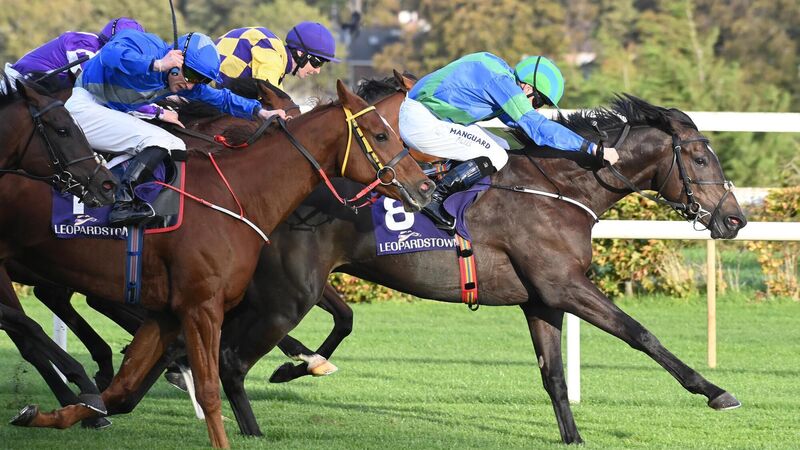Ruby Walsh: It beggar’s belief the BHA have made the same mistake twice

ADONIS: British eyes will be focused on whether they can pull a rabbit out of the hat for the Triumph Hurdle. Maybe Rare Middleton (seen here winning the Gables Foxrock Cup in October) will be just that. Pic: Healy Racing
That’s the nature of all major sporting events, and when any sport finds itself in the spotlight or becomes the biggest show in town, it attracts comment and scrutiny from all quarters. Tennis experts appear in June, on Golf when the Majors roll out, and in rugby during the Six Nations.
When I say experts, I mean all the extra eyes who will watch the Wimbledon finals, the final rounds of the Majors, and those who will be interested in the Six Nations until their nation can’t win the Grand Slam.
Democracy entitles everyone to an opinion, but I can’t recall the tennis, golf or rugby authorities making changes to their rules or how they run their events because of the views of casual viewers.
Rugby has had to make the most significant changes for player welfare reasons, changes which have revolved around high tackles. The changes have allowed the attacking player to offload the ball in the tackle because the tackler can’t risk going high and potentially getting sent off. It’s a rule change that has made rugby a better watch and improved player safety, but it was made by the relevant authorities for improvement, not appeasement.
In tennis, the Australian Open regularly struggles with extreme heat and has changed and altered its limits many times as it tries to find the balance between improvement and appeasement but nailing it, even with the ability to talk to its competitors, is a struggle. So where am I going? To the latest BHA whip rule changes, which I commented on a few weeks ago.
Research, working groups and discussions took place over an extensive period to bring about these changes, but what appears to have been the massive cock-up, even with all those great minds working for one goal, has been the implementation. They were brought in for appeasement, backfiring spectacularly because fair trials and implementation periods were wholly overlooked.
Rugby changed its high-tackle laws for a trial period in the Varsity Cup in South Africa and Shute Shield in Australia first. They worked and were brought to the URC, Gallagher Premiership and Super Rugby before going to the international stage.
The changes may appease those who believed rugby had become too dangerous, but the implementation was fair to all the competitors. Trialed and tweaked at a lowish level, brought to the club game to allow players the time to get used to it while rugby fans watched, before being moved to the top where the casual eyes would see it.
The rules are occasionally still broken, but that sport has improved and appeased. Racing could have done the same. It has levels that match and surpass rugby’s options, so why has the BHA gotten this so wrong again?
Yes, again, because, in 2011, they introduced new rules which eventually became standard practice but only after alterations, needless suspensions, and a period of bedding-in that took months. With that came endless headlines relating to whip rule infringements and all the publicity the sport is attracting now for the wrong reasons.
It beggar’s belief that the same error could be made twice. It is so disappointing to write this because learning from previous experiences is surely common practice. Obviously not, but had the BHA just gone with an initial number reduction to buy itself time, it could have appeased those wanting change and improved the sport in the long run.
Its 2011 changes altered how jockeys rode, completely changing the timing of where they asked for maximum effort. The sport didn’t become any less of a spectacle, and these changes could improve the sport in time, but nobody thought of looking outside the box to find a fair transition.
Kempton and Fairyhouse host Saturday afternoon’s action, and Naas takes the centre stage Sunday as the clock ticks down on those looking to book a horse box space on the road to Cheltenham.
Ireland looks to hold the Triumph Hurdle aces at this late stage, but the British eyes will be focused on the Adonis Hurdle at Kempton to see if they can pull a rabbit out of the hat. Paul Nicholls has done so here in the past, and maybe Rare Middleton will be just that.
At Fairyhouse, the Grand National horses are on show in the Bobbyjo Chase, but Zenta in the Winning Fair at 1.35 and any number of horses, American Mike in particular, in the Tommy Carberry Handicap Hurdle at 2.45 will be of interest. Found A Fifty and Corbetts Cross are the exciting novices on show in the Johnstown Hurdle on Sunday at Naas, where Henry De Bromhead has found an ideal opportunity for Coeur Sublime in the Newlands Chase.









